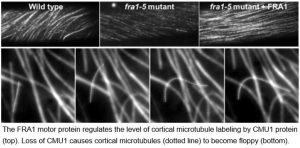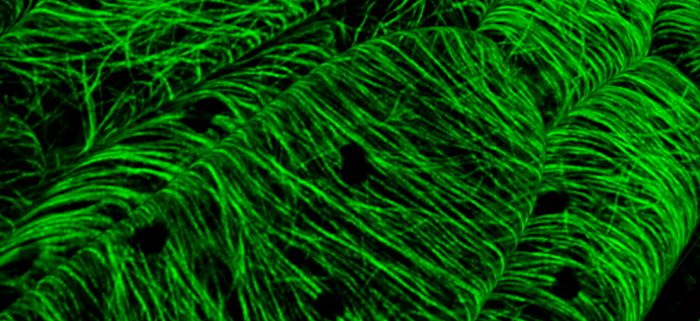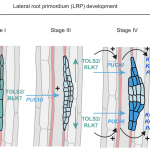How a motor keeps its track from wandering
Ganguly et al. establish that a transporter protein helps stabilize cell wall deposition sites.
Plant Cell https://doi.org/10.1105/tpc.19.00700
By Anindya Gangulya and Ram Dixit
Department of Biology and Center for Engineering Mechanobiology, Washington University in St. Louis, MO 63130, USA
a Current address: Center for Membrane and Cell Physiology, Molecular Physiology and Biological Physics, University of Virginia, Charlottesville, VA 22903.
Background: The plant body consists of cells cemented together by the wall surrounding each cell. The cell wall is made of cellulose fibers embedded within a hemicellulose and pectin network. These components need to be deposited in an orderly manner for the correct structure and function of the cell wall. This task is achieved by a scaffolding structure of microtubules beneath the plasma membrane. These cortical microtubules orient the movement of cellulose synthase complexes that produce cellulose and serve as tracks for motor proteins that transport vesicles containing other cell wall material. However, the massive cellulose synthase complexes can deflect cortical microtubules as they move through the plasma membrane. Therefore, cells need a way to keep cortical microtubules in place, particularly when the demand for cell wall production increases.
 Question: We had previously shown that the Arabidopsis thaliana FRAGILE FIBER1 (FRA1) motor protein is important for the deposition of non-cellulosic cell wall material. Here, we wanted to know which proteins bind to the cargo-binding portion of FRA1 and whether any of them are involved in cellulose deposition.
Question: We had previously shown that the Arabidopsis thaliana FRAGILE FIBER1 (FRA1) motor protein is important for the deposition of non-cellulosic cell wall material. Here, we wanted to know which proteins bind to the cargo-binding portion of FRA1 and whether any of them are involved in cellulose deposition.
Findings: We found that FRA1 directly binds to cellulose synthase-microtubule uncoupling (CMU) proteins that prevent the deflection of cortical microtubules by motile cellulose synthase complexes. In Arabidopsis seedlings, FRA1 increased the amount and microtubule localization of CMU1. Loss of FRA1 or CMU1 caused cortical microtubules to be floppy and even detach from the plasma membrane. Furthermore, we showed that phosphorylation of FRA1 provides a way for cells to control the extent of microtubule localization of CMUs and consequently the ability of cortical microtubules to withstand forces that would change their path. Our findings demonstrate that in addition to working as a transport motor, FRA1 helps to rivet cortical microtubules in place to stabilize the sites of cell wall deposition.
Next steps: We want to know exactly how FRA1 affects the microtubule localization of CMUs and whether it does so directly or indirectly through other proteins. Since CMUs bind to the cargo-binding region of FRA1, we are also interested in knowing whether CMUs affect FRA1’s ability to bind to cargo.
Anindya Ganguly, Chuanmei Zhu, Weizu Chen and Ram Dixit. (2020). FRA1 Kinesin Modulates the Lateral Stability of Cortical Microtubules Through Cellulose Synthase–Microtubule Uncoupling Proteins. Plant Cell; DOI: https://doi.org/10.1105/tpc.19.00700




